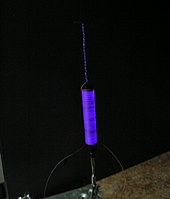
Back تفريغ هالي Arabic Tac boşalması Azerbaijani Коронен разряд Bulgarian Efecte corona Catalan Koróna (elektrotechnika) Czech Кăшăллă хухăм CV Koronaudladning Danish Koronaentladung German Efecto corona Spanish Koroonalahendus Estonian
This article has multiple issues. Please help improve it or discuss these issues on the talk page. (Learn how and when to remove these template messages)
|




A corona discharge is an electrical discharge caused by the ionization of a fluid such as air surrounding a conductor carrying a high voltage. It represents a local region where the air (or other fluid) has undergone electrical breakdown and become conductive, allowing charge to continuously leak off the conductor into the air. A corona discharge occurs at locations where the strength of the electric field (potential gradient) around a conductor exceeds the dielectric strength of the air. It is often seen as a bluish glow in the air adjacent to pointed metal conductors carrying high voltages, and emits light by the same mechanism as a gas discharge lamp (Chemiluminescence). Corona discharges can also happen in weather, such as thunderstorms, where objects like ship masts or airplane wings have a charge significantly different from the air around them (St. Elmo's fire).
In many high voltage applications, corona is an unwanted side effect. Corona discharge from high voltage electric power transmission lines constitutes an economically significant waste of energy for utilities. In high voltage equipment like cathode ray tube televisions, radio transmitters, X-ray machines, and particle accelerators, the current leakage caused by coronas can constitute an unwanted load on the circuit. In the air, coronas generate gases such as ozone (O3) and nitric oxide (NO), and in turn, nitrogen dioxide (NO2), and thus nitric acid (HNO3) if water vapor is present. These gases are corrosive and can degrade and embrittle nearby materials, and are also toxic to humans and the environment.
Corona discharges can often be suppressed by improved insulation, corona rings, and making high voltage electrodes in smooth rounded shapes. However, controlled corona discharges are used in a variety of processes such as air filtration, photocopiers, and ozone generators.